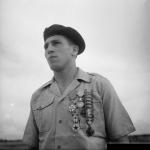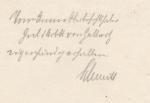-
Posts
29,251 -
Joined
-
Last visited
-
Days Won
84
Content Type
Profiles
Forums
Blogs
Gallery
Events
Store
Everything posted by Chris Boonzaier
-
Man... its lonely in here.... To the staff photo.. Unfortunately only the remark that it was given to him personally by von Gallwitz. A date would not have been bad. I wonder if it is the staff of the shortly existing Heeresgruppe von Gallwitz? It existed briefly in late 1916. I dont suppose anyone can say "the collar on the third jacket from the left is a kind only used in August 1916" or something similar? I thought not... :-(
-

EK 1914 Various kinds of non combat EKs
Chris Boonzaier replied to Chris Boonzaier's topic in Germany: All Eras: The Iron Cross
I landed another white ribbon doc today, ex navy, serving in a navy docyard as a kaiserlichen marine-intendanturrat when he got the white ribboned cross. As time goes on I become more and more convinced 1) Outside the borders of the reich there were only black ribboned crosses, either for fighters, or servers. 2) inside germany you could get a white OR black ribbon, the line dividing these two is not so clear. But basically the "White ribbon non-combattant" is a misnoner, because all non combattants outside germany seem to have got black ribbon crosses (Priests, Doctors, Administarive posts, Staff people, Civilian Commissars etc) instead of white ribbons.... i.e. all white ribbons were non combattants, but not all black ribbons were combattants... many black ribbons being for service. -
A French medical post at Verdun... "The bloody bandages are dropped on the floor, we have no time to dispose of them. They form a carpet that is ankle high on the floor. An artilleryman is brought in, he is in terrible condition. His wounds are horrible, he has bled a lot, his face like white marble. Both his legs are smashed, attached with just a few strands of meat and sinew. He is still bleeding heavily. While he is being given a morphine injection a doctor examines him. The splintered bones stick in all directions, the wound is full of hanging bits of flesh, remains of his trousers and underwear. Carefully we try and bandage the wounds. This means moving the leg... there is a fountain of blood that shoots out, like liquid pouring out of a keg it soaks the doctor. The poor man lets out a low moan and dies, it happens so fast we are not prepared for it, we almost don't notice it. New screaming at the entrance, this time a wounded man with a chest full of bullet holes, all bleeding badly. He is bandaged, gets a morphine injection is sent into a deep sleep with ether... he is then carried out... "Big black patches marked the places where the stretchers stood before the wounded were carried into the surgery. Leaning against the wall were the empty stretchers, their canvas covers stained black with crusts of blood. The bearers stand around with haggard faces, tortured looks, as if sentenced to death. Behind the barn the sight is terrible. Wounded who had died on the way, or during bandaging had been pushed aside to make way for those who were still living. There they lay, piled up on each other, open torsos, missing limbs, terrible to see. The faces carry grimices of anger, pain or desperation while the bodies lay in grotesque positions. On a ground lay the remains of a captain, three ribs and half a face wrapped in a tunic. Next to it lays a similar package with a paper name tag. The pile of bloody corpes is the stuff nightmares are made of. At night the rats add to the horror, eating away the faces and eyes, leaving bloody skulls staring out of empty sockets. Bury them? There are simply to many. We have to live amongst them, eat amongst them and sleep amongst them...."
-
Captain Albert Garnier, a French officer in the 52 I.D. wrote of the fate of those who lay in no-man's-land... On my reconnaissance today I found four poor wretches with smashed legs. For two days they had been laying there wasting away, wracked with fever. They lay a few meters from each other, talking back and forth, keeping each others morale up, all hoping to be brought back to safety. They begged me to arrange transport for them and I solemnly promised to send the stretcher bearers to come pick them up. I did not have the heart to tell them that the stretcher bearers were 20 meters away, dead. I had promised to report their position which I did as soon as I had the chance. I have no idea if they were found." A letter from a soldier of the 4th Infantry Regiment, November 1916. "At Verdun the ones who have suffered the most are the wounded and, along with them, the stretcher-bearers who transport them. Some of the bearers carry them from the front lines all the way to our post (1.5 kilometers); other ones take them in order to carry them off to Fleury and, having arrived there, the wounded have almost another 2 kilometers to go by stretcher before they can be transported by car. Imagine such a trip under the shells which hardly ever stop, through a landscape full of shell holes, tree trunks, and wrecked wire, through deep mud and, in certain areas, through clay where the stretcher-bearers sink down all the way to their waists, being forced to call for help to get themselves out of difficulty..."
-
The letter by General von Hoehn is one of those great Ebay finds. Sometimes historically interesting things get overseen by collectors. It was written by von Hoehn at the end of 1916 to major Paul Schmitt. Amongst the lines relating to Major Schmitts military postings are some great insights into the military situation at the end of 1916. Von Hoehn mentions his 50km long mountainous section of the western front and the fact that he has mainly territorial units under his command. Not only that, he has battered and depleted units from other sectors who, when they arrive are so lethurgic that in one case the French managed to capture 11 men in a bunker, something that would not have happened to the Landwehr/trrrotorial troops. There is a bit of complaining about the fact that the Bavarians are often the disadvantaged cousins, used and abused by the Prussians. Historically the most interesting part is his answer to a point raised by Schmitt in a previous letter, probably relating to German tactics and losses on the Somme. Von Hoehne mentions he was present at a conference (end of 1916) where a new tactical doctrine was worked out, one which Ludendorff was in agreement with. He also mentions fellow commanders (to remain unamed) who did not agree with these new doctrines. He accuses them of wasting the lives of their men to test theories that would have made von Clauswitz turn in his grave. The doctrines that von Hoehn helped formulate must have been the flexible defence in depth doctrine attributed to Ludendorff, the commanders who were against it were probably those who did their best not to implement it, the visable results of their course of action becoming apparent during the allied offensives in 1917. The simply typed sheet of paper is a great little piece of history... It makes one just love Ebay....
-

A real man.....
Chris Boonzaier replied to Chris Boonzaier's topic in Northern European & Baltic States
I guess he was at the stage when he just yawned when he got another medal. Its nice to get another gong for your chest... but just to be able to add a 10th little star must make you feel a bit cheated... imagine if it was the Russian system and he actually wore 12 wound medals and god knows how many Croix de guerres !!! -

A real man.....
Chris Boonzaier replied to Chris Boonzaier's topic in Northern European & Baltic States
Hi, A French officer who served in the resistance in WW2 then a commando in North Vietman in the Indochina conflict. -
-
I am trying to buy up diverse docs to a bavarian Major on Ebay, unfortunately no award docs. But there are great little things, like this one from General von Hoehn really interesting content, especially the part about the Somme on the last page !!!! Also included is a handwritten piece of paper which i am having a bit of trouble with. Also a ?ic of the major. I will add more of his stuff here as I hopefully get it....









